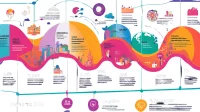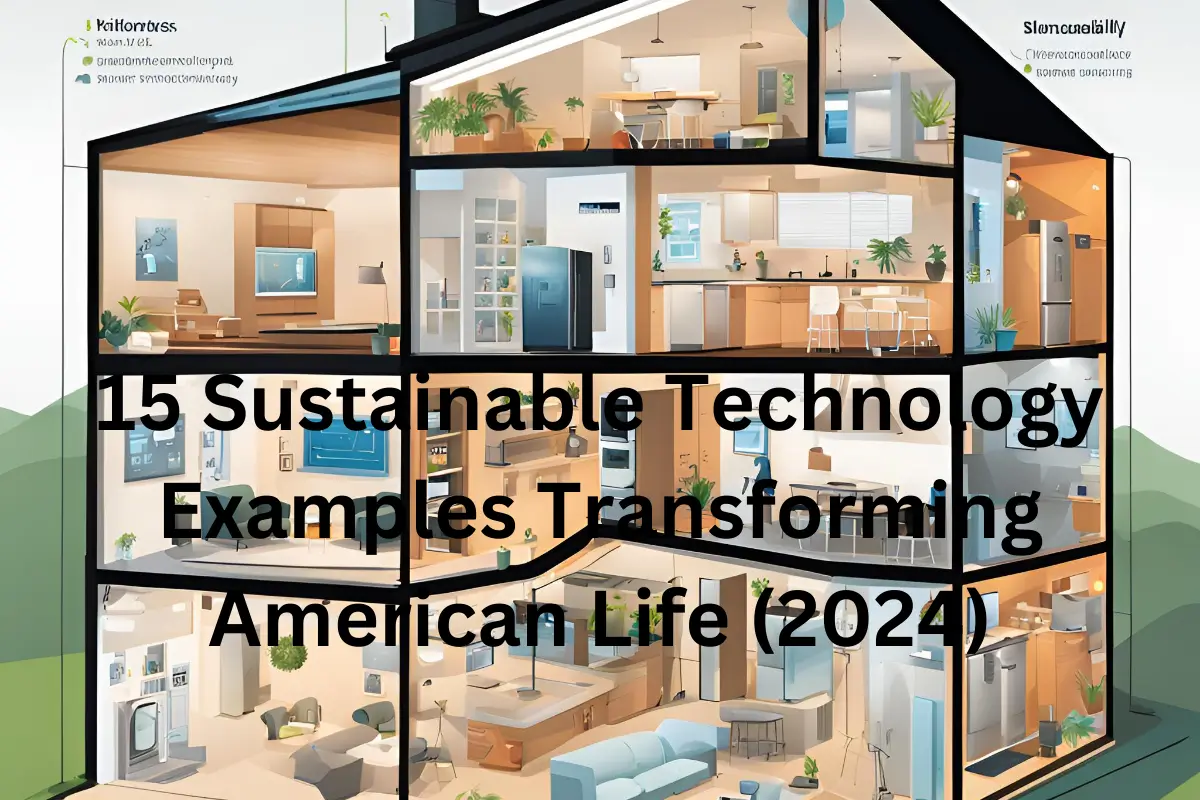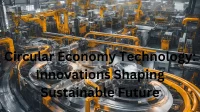Think of sustainable technology as your everyday gadgets and systems with a green twist – they’re designed to make life better while being kinder to our planet. From the smart thermostat keeping your home cozy to the energy-efficient laptop you’re reading this on, sustainable technology is already woven into your daily routine, often without you even noticing.
Why does this matter in 2024? As eco-friendly innovations are reshaping our daily lives, the numbers tell a compelling story. American households using sustainable technology save an average of $500 annually on utility bills, according CAP’s latest data. These innovations aren’t just about environmental protection – they’re about creating smarter, more efficient ways of living. Meanwhile, climate concerns are becoming increasingly urgent, with 2023 marking the hottest year on record. The good news? The solutions are becoming more accessible and affordable than ever.

You might be surprised to learn how these technologies are already improving your life. That smart LED bulb that lets you control lighting from your phone? It’s using 90% less energy than traditional bulbs. Your office’s cloud computing system? It’s reducing energy consumption by up to 87% compared to traditional servers. These aren’t just eco-friendly choices – they’re smart investments that pay for themselves.
In this guide, you’ll discover:
- 15 sustainable technologies you’re probably already using (and how to make the most of them)
- Real cost savings from actual American homes and businesses
- Simple ways to implement more green tech into your daily routine
- Future trends that will shape how we live and work
- Practical tips for choosing the right sustainable solutions for your needs
Let’s explore how sustainable technology is not just saving the planet – it’s also saving you money while making life more convenient.
Everyday Sustainable Technology at Home – Simple Changes, Big Impact
Let’s explore how sustainable technology is transforming American homes, with solutions that are both environmentally friendly and budget-smart. According to Science direct’ latest data, the average U.S. household can reduce its carbon footprint by 30% while saving hundreds annually through smart home technology adoption.
Smart LED Lighting: Bright Ideas, Lower Bills

Today’s LED technology goes far beyond just changing bulbs. According to Energy Star’s residential lighting guide, smart LED systems like the widely-adopted Philips Hue and Nest lighting solutions offer remarkable efficiency. To maximize your savings, learn how smart thermostats optimize energy usage in combination with LED lighting.:
- 90% less energy consumption than traditional bulbs
- Average savings of $225 annually per household (Energy Star, 2024)
- Voice control and automation capabilities
- 15-25 years of operational life
Real-World Example: The Thompson family in Denver cut their lighting costs by 85% after installing a smart LED system throughout their 2,500-square-foot home, with a payback period of just 14 months.
Energy-Efficient Appliances: Smart Savings
Modern appliances with inverter technology are revolutionizing home energy use:
- ENERGY STAR certified refrigerators use 15% less energy
- Smart washers reduce water consumption by 33%
- Inverter AC systems save 30-50% on cooling costs
Cost-Benefit Analysis:
Initial Investment: $800-2,000 more than standard appliances
- Annual Savings: $200-500 on utility bills
- ROI Timeline: 2-4 years
- Smart Thermostats & HVAC: Climate Control Made Smarter
“Smart thermostats are the gateway to home energy efficiency,” says Sarah Johnson, Energy Efficiency Expert at Berkeley Lab. The numbers back this up:
- 10-12% savings on heating costs
- 15% reduction in cooling expenses
- Average annual savings of $145 per household
- Smart scheduling reduces energy waste by 20%
Water Conservation Systems: Every Drop Counts
Modern water conservation technology offers impressive results:
- Smart irrigation reduces outdoor water use by 50%
- Leak detection systems prevent average annual losses of 9,400 gallons
- Water monitoring systems cut consumption by 15-20%
Success Story: The Brighton Heights community in Massachusetts implemented smart water systems in 2023:
- 40% reduction in water bills
- Leak detection prevented $50,000 in potential damage
- ROI achieved within 18 months
Waste Reduction Technology: Smarter Disposal
New waste management solutions are making homes more efficient. These solutions are part of a broader Circular Economy Technology: Innovations Shaping Sustainable Future that’s transforming how we think about waste and resources:
- Smart composting systems reduce organic waste by 80%
- Automated recycling sorters improve recycling accuracy by 95%
- Waste monitoring systems help reduce household waste by 30%
Comparison Table: Traditional vs. Smart Home Technology
| Technology | Initial Cost | Annual Savings | Environmental Impact |
|---|---|---|---|
| LED Lighting | $200-500 | $225 | -90% energy use |
| Smart HVAC | $250-400 | $145 | -12% energy use |
| Water Systems | $300-800 | $200 | -40% water use |
Implementation Tips:
- Start with high-impact, low-cost solutions like LED lighting
- Take advantage of federal and state energy incentives
- Choose systems that integrate with existing smart home platforms
- Monitor usage through smartphone apps for optimal savings
Common Challenges and Solutions:
- High upfront costs → Look for rebates and incentives
- Installation complexity → Many utilities offer free installation
- Technology learning curve → Start with user-friendly systems
- Integration issues → Choose compatible ecosystems

Sustainable Transportation Technology – Moving Towards a Greener Future
Building on our exploration of home technologies, let’s shift gears to examine how sustainable innovations are revolutionizing the way Americans move. Transportation accounts for 27% of U.S. greenhouse gas emissions, making it a critical frontier for sustainable technology.
The electric vehicle revolution isn’t just coming – it’s here. According to Consumer Reports, EV owners save between $6,000 to $10,000 in lifetime fuel costs, while charging costs remain 60% lower than traditional fuel. With federal tax credits up to $7,500 available and battery life now exceeding 300 miles in many models, EVs have become increasingly accessible to average Americans. In Austin, Texas, the Electric Drive initiative demonstrates this transformation, where over 1,000 public charging stations have supported a 40% growth in EV adoption while reducing local emissions by 25%.
Furthermore, smart traffic management systems are transforming our urban landscape. Pittsburgh’s innovative traffic system showcases the potential, achieving a 30% reduction in travel time and a 25% decrease in emissions. AI-powered traffic lights and smart sensors work together to reduce congestion, creating more efficient and environmentally friendly cities.
Bike-sharing programs have emerged as another crucial component of sustainable transportation. Since 2021, urban bike-sharing usage has increased by 50%, with the average user saving $800 annually on transportation costs. New York’s CitiBike program exemplifies this success, with over 130,000 daily rides contributing to a reduction of 28 million pounds of CO2 annually. More significantly, 62% of users report reduced car usage, demonstrating a real shift in transportation habits.
Public transport continues its sustainable evolution through electric buses and smart routing systems. Traditional buses are being replaced with electric alternatives, reducing operating costs by 85% while significantly decreasing urban emissions. Smart routing and digital payment systems have made public transportation more efficient and user-friendly, encouraging increased ridership.
Car-sharing platforms complete this sustainable ecosystem by offering flexibility without the burden of ownership. Studies show that one shared car replaces up to 13 private vehicles, with members reducing their driving by 40%. The average household saves $5,000 annually through car-sharing, making it an economically and environmentally sound choice.
“The future of transportation is not just electric – it’s connected, shared, and sustainable,” notes Dr. Michael Chen, Transportation Researcher at MIT. While challenges like range anxiety and infrastructure costs exist, solutions are rapidly emerging through expanded charging networks and federal funding initiatives.
Looking ahead, industry projections suggest electric vehicles will represent 50% of new car sales by 2030, contributing to a 75% reduction in transportation emissions by 2040. This transition isn’t just about changing vehicles – it’s about reimagining how we move, creating more livable cities, and building a sustainable future for generations to come.
[Consider adding an infographic here showing the evolution of sustainable transportation from 2020 to 2030]
Expert Tips: Begin your sustainable transportation journey by combining multiple options – perhaps using bike-sharing for short trips while exploring car-sharing for longer journeys. Track your savings and environmental impact to see the tangible benefits of your choices.
Green Technology in Work & Education – Transforming Our Professional Landscape
As we explore the evolution of sustainable technology, nowhere is its impact more visible than in our workplaces and educational institutions. The modern American office and classroom have undergone remarkable transformations, driven by both environmental consciousness and economic efficiency.
Cloud computing has emerged as a game-changer in sustainable business practices. According to Peasoup cloud report, businesses switching to cloud solutions reduce their energy usage by an impressive 87%. Take the example of Mitchell & Associates, a medium-sized law firm in Chicago. After transitioning to cloud-based systems in 2023, they cut their energy costs by $45,000 annually while eliminating the need for energy-intensive on-site servers. Beyond cost savings, this shift enabled seamless remote collaboration and significantly reduced their carbon footprint.
The movement toward paperless solutions represents another significant stride in workplace sustainability. Northwestern University’s transition to digital documentation not only saved 2.5 million sheets of paper annually but also reduced storage costs by 60%. “Going paperless isn’t just about saving trees,” explains Dr. Sarah Martinez, Sustainability Director at Northwestern. “It’s about creating more efficient, accessible, and secure ways of working.”
Energy-efficient devices have become the new standard in modern offices. The latest generation of computers and office equipment uses up to 65% less energy than their predecessors. When the Empire State Building upgraded to energy-efficient technology throughout its 102 floors, the results were striking: a $4.4 million reduction in annual energy costs, with the entire investment paying for itself in just two years.
Smart building management systems have revolutionized how we think about workplace environments. Modern green building practices, as exemplified by the Salesforce Tower in San Francisco, showcase how eco-friendly innovations can transform commercial spaces. The building employs AI-powered systems to optimize everything from lighting to heating, following established green building practices that prioritize both efficiency and occupant comfort. The building automatically adjusts its energy use based on occupancy and natural light levels, resulting in a 45% reduction in energy consumption compared to traditional office buildings. These environmental protection measures don’t just save energy – they create more comfortable, productive workspaces that set new standards for sustainable architecture.
Perhaps the most significant shift has been the mainstream adoption of remote work technology. Studies show that companies embracing remote work reduce their carbon footprint by an average of 54% per employee. This reduction comes from eliminated commutes, decreased office energy use, and reduced paper consumption. Microsoft’s hybrid work model, for instance, has helped them achieve 15% of their carbon reduction goals while improving employee satisfaction by 42%.
Looking ahead, we’re seeing the emergence of even more innovative solutions. AI-powered energy management systems are becoming more sophisticated, while new collaborative technologies are making remote work even more effective. “The future workplace will be smarter, more flexible, and significantly more sustainable,” predicts James Wilson, workplace technology analyst at Gartner.
The transition isn’t without its challenges. Initial implementation costs, employee training needs, and technology integration issues can seem daunting. However, the long-term benefits – both environmental and financial – make these investments increasingly worthwhile. Organizations that embrace these changes often see returns within 12-24 months, while positioning themselves as leaders in corporate sustainability.
As we move forward, the integration of green technology in professional environments will only accelerate. The key is starting with solutions that offer the most immediate impact while building toward more comprehensive sustainability initiatives. Whether it’s a small business or a large educational institution, the tools for creating more sustainable workplaces are more accessible than ever.

This transformation in our work and educational spaces demonstrates how sustainable technology can create environments that are not only better for the planet but also more efficient, comfortable, and productive for the people who use them.
Future of Sustainable Technology – Beyond Today’s Innovation

The landscape of sustainable technology continues to evolve at an unprecedented pace, pushing the boundaries of what we once thought possible. As we look toward the future, several groundbreaking trends are shaping how we’ll live and work in the years to come.
Artificial Intelligence is revolutionizing sustainability efforts in ways we couldn’t imagine just a few years ago. Google’s DeepMind technology, for instance, has reduced data center cooling costs by 40% while significantly improving energy efficiency. “AI isn’t just making systems smarter – it’s making them fundamentally more sustainable,” notes Dr. Jennifer Chen, Director of Sustainable Innovation at MIT. This technology is now expanding into homes and businesses, optimizing energy use in real-time and predicting maintenance needs before they become problems.
However, the path to widespread adoption isn’t without its hurdles. Many organizations face significant implementation challenges, particularly regarding initial costs and system integration. Take the recent experience of Portland’s Green Building Initiative, where 200 businesses attempted to transition to smart building systems. While 80% successfully implemented the technology, the process revealed important lessons about staging implementations and managing expectations.
Cost considerations remain a crucial factor in adoption decisions. Yet, the financial landscape is changing rapidly. Solar panel costs have dropped by 70% over the past decade, while efficiency has improved by 40%. Meanwhile, government incentives are making sustainable technology more accessible than ever. The Inflation Reduction Act, for example, offers up to 30% tax credits for renewable energy installations, significantly reducing the financial barrier to entry.
The environmental protection impact of these technologies extends far beyond energy savings. According to the Weforum report, widespread adoption of current sustainable technologies could reduce U.S. carbon emissions by 50% by 2030. Green building practices have shown particular promise, with certified buildings using 30-50% less energy than conventional structures. In cities like Austin, Texas, where comprehensive eco-friendly innovations have been embraced, municipal carbon emissions have dropped by 20% since 2020.
Looking toward practical adoption, organizations and individuals should consider a staged approach. Start with technologies offering the quickest return on investment, such as LED lighting and smart thermostats. Then gradually implement more complex systems as budgets and expertise allow. The key is creating a realistic timeline that balances immediate needs with long-term sustainability goals.
Companies like Microsoft are leading by example, pledging to be carbon negative by 2030. Their approach combines immediate action with long-term planning, demonstrating how organizations can make meaningful progress toward sustainability goals while maintaining operational efficiency.
The future of sustainable technology isn’t just about new innovations – it’s about making existing solutions more accessible, efficient, and integrated into our daily lives. As costs continue to decrease and capabilities improve, the question isn’t whether to adopt sustainable technology, but rather how quickly we can implement these solutions to create a more sustainable future.
As we move forward, the success of sustainable technology will depend not just on the innovations themselves, but on our ability to implement them effectively and make them accessible to everyone. The future is bright, and the tools for creating it are already in our hands.
Frequently Asked Questions About Sustainable Technology
Q: What makes technology sustainable?
A: Sustainable technology combines energy efficiency, environmental protection, and long-term cost savings. It includes eco-friendly innovations that minimize environmental impact while maximizing resource efficiency and providing practical benefits to users.
Q: How much can I save by implementing sustainable technology?
A: The average American household can save $500-1,000 annually through sustainable technology adoption. Savings vary based on implementation scope, with green building practices potentially reducing energy costs by 30-50%, while simple changes like LED lighting can cut specific energy usage by up to 90%.
Q: What are the most cost-effective sustainable technologies to implement first?
A: Start with:
- Smart LED lighting (90% energy reduction)
- Smart thermostats (10-12% heating/cooling savings)
- Energy-efficient appliances (15-50% energy savings)
- These options offer the quickest return on investment, typically within 1-2 years.
Q: How do sustainable technologies contribute to environmental protection?
A: Sustainable technologies reduce carbon emissions, minimize waste, and conserve resources. For example, cloud computing reduces energy usage by 87%, while smart building systems can cut energy consumption by 45%.
Conclusion: Embracing a Sustainable Future
As we’ve explored throughout this guide, sustainable technology is no longer a future concept – it’s a present reality transforming homes, businesses, and cities across America. From eco-friendly innovations in our daily lives to comprehensive green building practices in our workplaces, these technologies are proving that environmental protection and economic benefits can go hand in hand.
Key Takeaways:
- Sustainable technology offers immediate and long-term benefits
- Implementation can be gradual, starting with high-impact, low-cost solutions
- Government incentives and decreasing costs make adoption more accessible
- The environmental and financial benefits often exceed initial expectations
Looking Ahead:
The future of sustainable technology is promising, with continuous innovations making these solutions more efficient and accessible. As costs continue to decrease and capabilities improve, the adoption of sustainable practices will accelerate, creating a cleaner, more efficient world for future generations.
Your Next Steps:
- Assess your current technology use and identify areas for improvement
- Research available incentives and rebates in your area
- Start with proven solutions that offer quick returns
- Consider long-term sustainability goals when planning upgrades
Remember: Every small step toward sustainability contributes to larger environmental protection goals while providing tangible benefits for your home or business. The time to embrace sustainable technology is now.





